Half a century at sea
Posted by Chris Graham on 10th August 2020
The small, 1960s cruise ship Funchal enjoyed half a century at sea thanks largely to the passion of one man. This is her story.
Seven years ago, and despite more than half a century at sea, the future of the small Portuguese cruise ship, Funchal, seemed bright. Despite her age, she’d been extensively refurbished for further service, and was looking particularly smart in her freshly-painted, retro livery. Sadly, though, her new owners foundered within two years, and the handsome vessel has since been laid up in Lisbon.
The classic ship traces her origins back to the late 1950s, when the Portuguese shipping company Empresa Insulana de Navegação made plans for a new vessel to serve its passenger and mail route from Lisbon to the Portuguese archipelagos of Madeira and the Azores, and Spain’s Canary Islands. Taking her name from Madeira’s capital, the 9,800gt Funchal revolutionised travel to the islands with her comfort and speed.
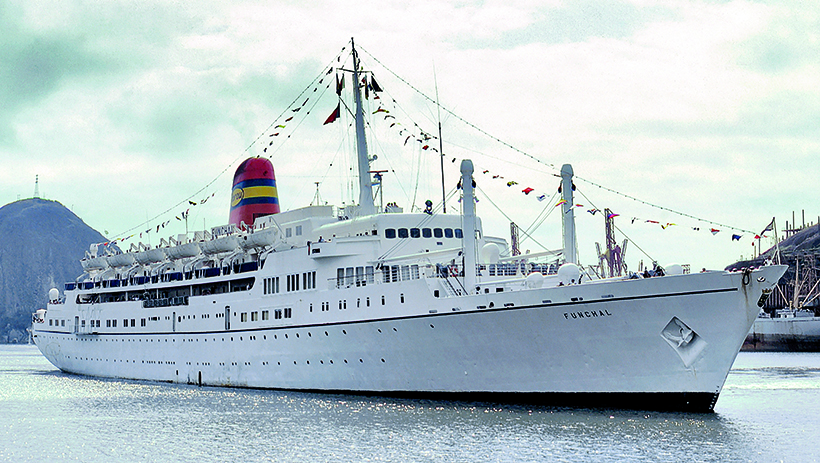
Wearing CTM funnel colours and the name of charterer, Abreu, Funchal dressed overall in Vitoria, Brazil, in December 1981.
Launched in 1961
Funchal was launched at Denmark’s Elsinore Shipyard in February 1961, and reached her homeport of Lisbon for the first time on October 19th of that same year. With a black hull and buff funnel, the yacht-like vessel had elegant lines, although the terracing of her aft decks below the height of the bow made her stern appear foreshortened. The new flagship could accommodate 400 passengers in three classes, and was also equipped with three cargo holds, two forward and one aft.
Funchal departed Lisbon on November 4th, 1961, on her maiden voyage to the islands, making calls at Funchal and the Azorean ports of Ponta Delgada, Horta and Angra do Heroísmo. As well as her regular liner voyages, she undertook sporadic cruises, and occasionally served as the presidential yacht on state visits to the Atlantic islands, Cape Verde, Guinea-Bissau and Brazil.
With the increasing air travel to the islands in the early 1970s, Funchal was sent to Amsterdam in late 1972, for an extensive refit to convert her into a single-class cruise ship. In addition to an upgrade of accommodation and public areas, the original Parsons turbines were replaced with more economical diesel engines. Sporting a white hull, she returned to service in the summer of 1973, still sailing to the Atlantic islands, but now on a cruise circuit which included Zeebrugge and Dover.
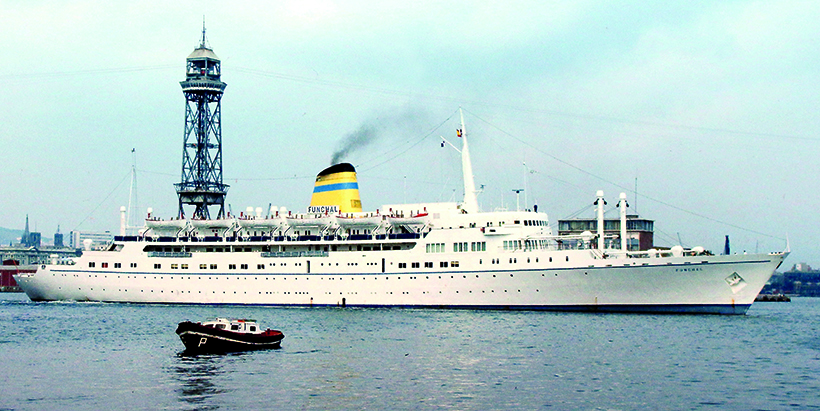
This 1986 view of Funchal, in Barcelona, shows her stern prior to a succession of modifications made during the 1990s. She carried these funnel colours between 1986 and 2000.
In early 1974, Insulana merged with the Colonial Company to form the soon-to-be-state-owned Companhia Portuguesa de Transportes Marítimos (CTM). Funchal resumed service on the Atlantic islands run later that year but, by October 1975, she was laid-up in Lisbon and facing an uncertain future. With her homeland in political and economic turmoil, there was no domestic market to sustain a year-round cruise ship, even one as small as Funchal.
New sources of income
CTM needed to look elsewhere for income, and charters to foreign tour operators became the vessel’s lifeblood. On the first such charter, Funchal came into contact with a man who was to play a pivotal role in her life for the next 36 years; the Greek-born George Potamianos.
Sailing in the summer for Sweden’s Fritidskryss, a partnership with Potamianos, Funchal cruised the waters of Northern Europe from Gothenburg, serving both Swedish and international markets. In spring and autumn she cruised from Lisbon to the Atlantic islands and Mediterranean, while winter saw her migrate to the warmer waters of South America, where she sailed on a range of coastal itineraries out of Brazilian ports.

Funchal 0ff Calshot in October 1999, just before the addition of accommodation on Azores Deck aft. Two tenders were housed forward of her superstructure from the late 1980s to there early 2000s.
With some exceptions, this was the pattern of the ship’s deployment for the best part of three decades. In later years, she also cruised from other Northern European ports for numerous different charterers, and Funchal was never a conventional cruise ship in the sense of operating year-round for a single company.
In 1985, the Portuguese government liquidated CTM, and Funchal was put up for sale. Having built up a successful summer charter operation, Potamianos and partners saw potential in the vessel and, under the name of Great Warwick Inc, purchased her at auction.
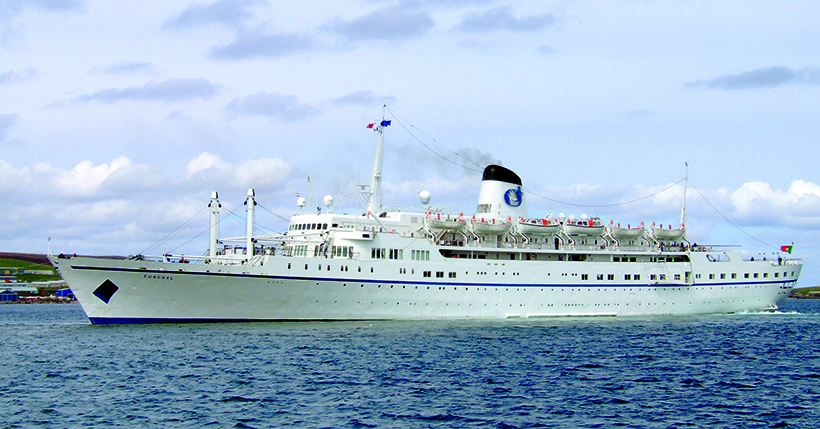
Funchal’s built-up stern is evident in this mid-2000s view from her Classic International Cruises days.
Funchal was reregistered in Panama, but operations continued largely unchanged under the management of Potamianos’ Lisbon-based Arcalia Shipping. Arcalia’s success with Funchal led to the acquisition of further older tonnage in the ensuing years, starting with the handsome former Portuguese liner Infante Dom Henrique, which was renamed Vasco da Gama, and the fleet grew to five in number. From the late 1990s Funchal and her fleetmates sailed under the Classic International Cruises banner, although they continued to spend much of their time on charter.
Structural changes
Most successful transitions from liner to cruise ship have involved external modifications, but it was not until the 1990s that Funchal’s structural appearance changed significantly. In 1992, the Azores Deck was extended aft, covering the previously open area on Madeira Deck below. Rather than scarring the vessel’s original lines, it arguably enhanced them by giving her a more balanced profile.
The late 1990s brought further changes, including the replacement of the aft kingposts and mast, and a short extension to Navigators Deck. The installation of additional accommodation on Azores Deck in late 1999, resulted in the most substantial alteration to Funchal’s stern, but didn’t overly spoil her lines.
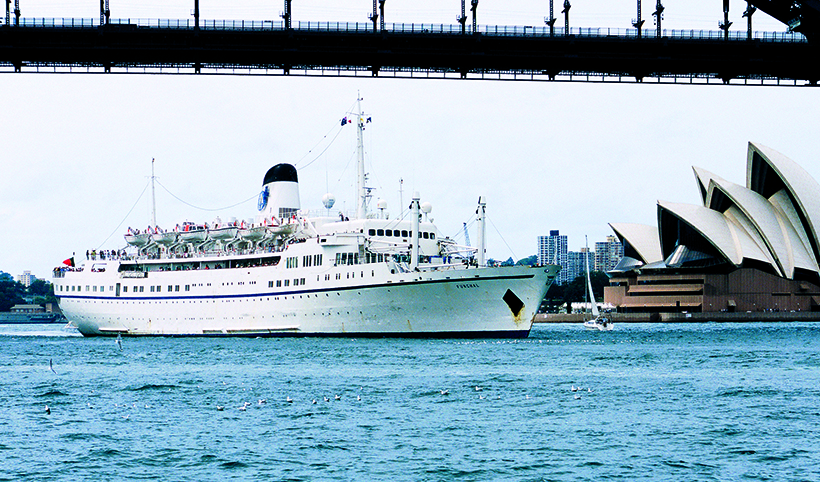
Passing the iconic Opera House in Sydney, Funchal arrives in the Australian port on March 4th, 2006, for an overnight call during a 35-night, clockwise, circumnavigation of Australia, from Fremantle.
As the cruise industry was increasingly homogenised in the 2000s with amenity-filled megaships, Funchal was at risk of becoming redundant. Her owners viewed the vessel’s size and charm as strengths rather than weaknesses, however, and she continued to operate profitably through a combination of strategic deployment and good upkeep.
Instead of competing head-on with more modern tonnage, Funchal was used in niche markets, generally sailing from smaller ports on non-repeating itineraries. Offering an alternative to mainstream cruising, she appealed to passengers seeking a traditional shipboard experience. Her predominantly Portuguese crew were one of the ship’s greatest assets, and helped maintain her national identity while she served foreign markets. This was aided by the return of the vessel to the Portuguese register in 2001.
New lease of life
Despite many years of service, Funchal’s sphere of operation was limited to Europe, North Africa, the east coast of South America and the Caribbean. In late 2004, however, she embarked on a new phase of her career, when she was deployed to Australia for a season of coastal and Bali cruises from Fremantle, the port for Perth.
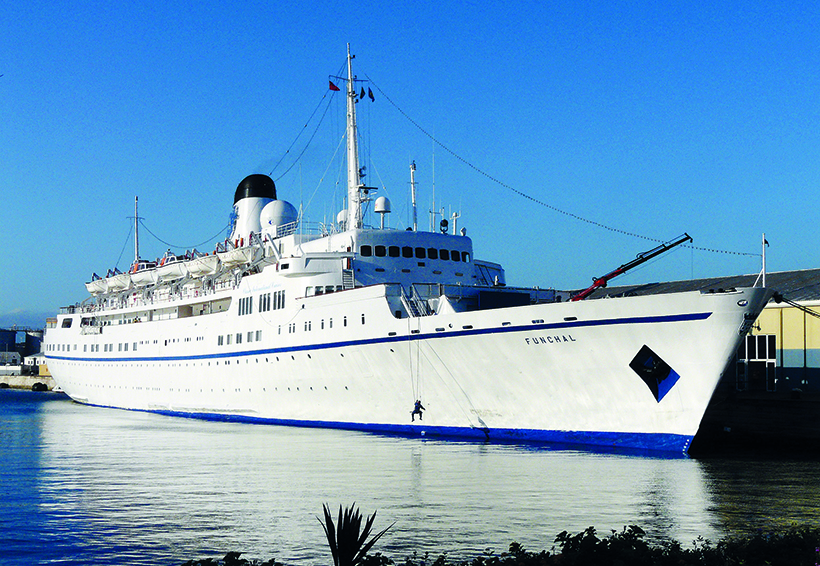
The removal of Funchal’s forward kingposts during the 2008-09 refit, left her bow somewhat bare, but created additional open deck space for passengers.
Marking a new era in cruising from the country’s west coast, Funchal proved popular, and returned for the following three southern summers. Her subsequent seasons included more adventurous voyages which took the ship further afield, including a 35-night circumnavigation of Australia, and a 41-night round trip from Singapore to north-east Asia.
At a time when most of the ship’s remaining contemporaries were heading to the breakers, Funchal was lovingly upgraded during the winter of 2008-09 in Lisbon. The work involved the first stage of an extensive refit to enable her to comply with Safety of Life at Sea (SOLAS) 2010 regulations, that would otherwise have put an end to her sea-going career. During the refit, the ship’s original forward cargo-handling equipment was removed, creating additional deck space overlooking her bow.
Further SOLAS 2010 compliance work commenced during the winter of 2010-11, and included an ambitious transformation of Funchal’s interiors to make them more spacious and luxurious. The costly project suffered various setbacks, however, and was not completed under George Potamianos’ watch.
The passion is lost
The Greek who had such a passion for the vintage Portuguese vessel, died in May, 2012, and the company he founded and led didn’t last much longer. In September, 2012, several members of the Classic International Cruises fleet were arrested, and the company ceased trading shortly thereafter. Tied up at a Lisbon pier with her refit incomplete, Funchal had not operated a cruise in two years, and seemed a likely candidate for the breakers’ torch.
But, in an unexpected turn of events, the ship and three of her fleet mates, were purchased in January 2013 by Portuguese entrepreneur, Rui Alegre, with the intention of returning them to service. Not deterred by a lack of experience in the industry, Alegre established Portuscale Cruises, with plans to carry on the Potamianos legacy. Work on Funchal resumed, and by August 2013 she was ready to return to service.
As part of her extensive upgrade, Potamianos had intended to repaint the ship in a livery similar to that of her early Insulana days. The plan was retained by Alegre, and Funchal entered service with Portuscale again sporting a black hull and yellow funnel. The new-look vessel set out from Lisbon for the first time on August 22nd, 2013, bound for her old summer homeport of Gothenburg, just as she had done 37 years earlier, when first chartered by Potamianos.
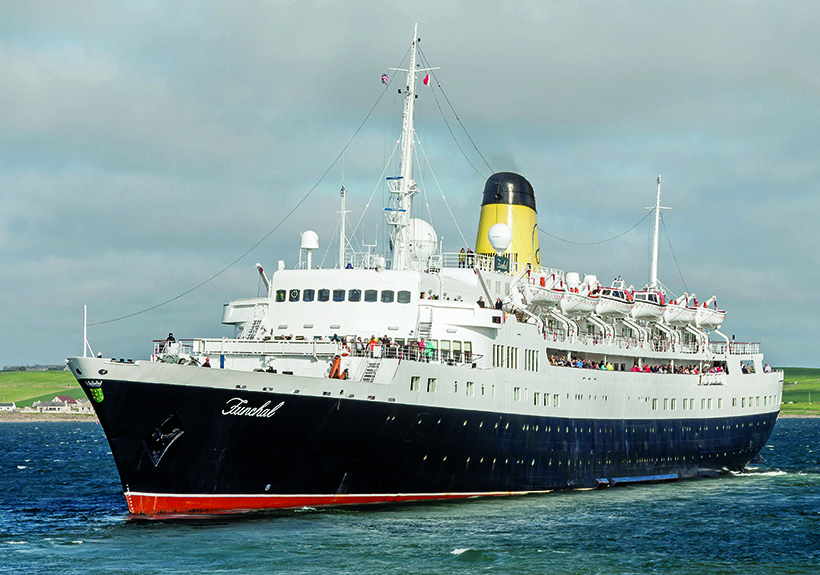
Funchal shows off a particularly flattering angle as she departs Hatson Pier, Kirkwall, bound for Invergordon, on June 7th, 2014.
While Portuscale experienced some success, the burden of start-up and vessel renovation costs eventually proved too great, and the fledgling company succumbed in early 2015. It was hoped that the recently-modernised Funchal would be picked up by another operator, but the vessel sat forlornly at her Lisbon berth slowly decaying.
In December 2018, it was announced that Funchal had been sold to UK-based Signature Living, for use as a hotel, later advertised as a ‘floating beach club’ in Ibiza. Curiously, marketing material indicated she would retain her name but depicted her in a garish livery that would have had George Potamianos turning in his grave. The ship was due to welcome her first guests in the summer of 2019, but the plans failed to materialise and, at the time of writing, Funchal remains in Lisbon, again for sale.
Very few cruise ships have seen service beyond their 50th birthday, and to have done so without a change of name or national identity, is very unusual. The sole survivor of a once-proud Portuguese passenger fleet, Funchal owes her good fortune and longevity largely to the passion and efforts of one man who believed she was viable, no matter how much the industry changed around her. Whatever the future holds for Funchal, she occupies a unique place in maritime history, and in the hearts of countless passengers, crew and others who came into contact with this charming ship.
For a money-saving subscription to Ships Monthly, simply click here





